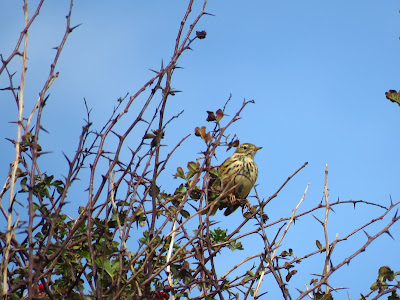
I took the train to Scarborough for a walk along the coastal Cleveland Way. The day started a bit misty, but warm, and soon the sun was shining and the light breeze atop the cliffs made for a wonderful summer feel walk. I headed straight for Scalby Mills, as I was keen to explore two ravines, Scalby Mill and Crook Ness. Both have a southerly aspect and I was wondering if an undiscovered population of Dark Bush-crickets might be lurking there. I'll give you the answer now: no Dark bush-crickets were found, however, there were other bush-cricket surprises!
Looking back with Scarborough Castle on the horizon.
It was nice to see a female Common Field Grasshopper jumping down from a concrete post and start to lay eggs on the soil. This is the only grasshopper species seen, but it was plentiful.
Long-winged Conehead habitat by the road.
Of course I had taken my bat-detector along. The first surprise was Long-winged Cone-heads on a patch of grassland by the road just up from the Scalby Mills pub. This wasn't a very large surprise through, as we saw the species at Ravenscar, a more northern location. Long-winged Cone-heads were calling all along the walk, they seem very established as they've been there for a while. Unfortunately the high temperatures meant that they weren't showing much, so no photos, just sound recordings of them.
I cross the bridge over Scalby Beck, always picturesque and much better on a sunny summer day!
View while climbing the small valley to carry on the Cleveland Way.
From the sea came the wailing calles of Oystercatchers and Curlew. Cormorants dried their wings on rocks as the falling tide exposed them and Grey Heron stood by rock pools having a go to pond dipping.
Grey Heron.
The walk gets more interesting as I start picking the first Roesel's buhs crickets on the grassland over Scalby Beck. They are numerous and the habitat forms a long strip along the path, so their whirring accompanies me along. Although I try to triangulate their position with the bat detector, I fail to spot any, probably also hiding inside the grass tussocks. When I get home I check and find these are the first Roesel's in VC62 and some of the northernmost in the UK.
The views of this walk are truly spectacular!
An interpretation board for Scalby Lodge ponds. No water was visible from the footpath.
Curlew.
I'm very pleased to spot a few Wall Butterflies basking on the footpaths...
or feeding on Creeping Thistle.
Arriving to Crook Ness.
The interpretation board has fallen to the ground. Interesting to read that the track to the beach along the ravine was used to collect building materials with donkey and cart. The cliffs are quite high and this is one of the few access points to the beach. The ravine is very narrow and steep, and there is a trickle of water on the beck. Ferns clothe the sides of the ravine, but it is very enclosed and as soon as you are on the beach it feels very dry. The only orthopterans to be seen or heard were Common Field Grasshoppers.
Common Field Grasshopper.
I have my packed lunch on a large boulder overlooking the sea. I'm quick, as there is a long way back to the train.
The bottom of Crook Ness.
There are reeds, but not many brambles at the bottom of the ravine.





































